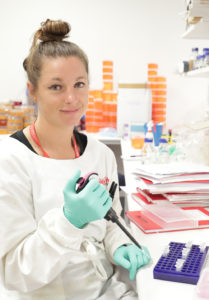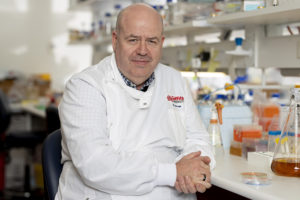
Research into the development of an early detection test for ovarian cancer at Griffith University’s has been given a $300,000 funding boost from The Bourne Foundation and a further significant funding pledge from Tour de Cure.
“Despite decades of research, there is currently no easily accessible, non-invasive and reliable early detection test to diagnose ovarian cancer, which leads to poor survivability rates,” said , who will conduct the research with colleagues , , and Associate .
Statistics indicate only 45% of all women diagnosed with ovarian cancer are likely to survive past five years. For women diagnosed in the advanced stages of the disease, the survival rate drops to 25%.
“With no substantial improvement in ovarian cancer survival rates over the past two decades, the key to ovarian cancer survival lies in the development of better diagnostic methods,” Professor Jennings said.
“If diagnosed early, over 90% of ovarian cancer patients could be cured. Tumours that are detected early before they have had a chance to spread can be completely removed by surgery, effectively curing the patient.”
Dr Shewell said their findings showed it was possible to detect a sugar, called Neu5Gc, in the blood of ovarian cancer patients that is not present in the blood of cancer-free women.

“This test may be a useful tool for early cancer diagnosis, as well as a tool for monitoring treatment and disease,” she said.
Neu5Gc is a type of sugar structure not produced by healthy human cells but can be found in human tumour tissues, tumour cells and tumour secretions. To develop a way of successfully and sensitively identifying the presence and levels of Neu5Gc, the Griffith research team, with collaborators at the University of Adelaide, designed a protein called SubB2M that can bind to and detect Neu5Gc.
A study was conducted to test the blood of women with ovarian cancer at all stages, from early to late stage diagnoses. Each woman showed increased levels of Neu5Gc compared to healthy controls, and late stage ovarian cancer patients had uniformly high levels of Neu5Gc detectable in their blood.
“The crucial question that remains to be answered is the identity of the blood proteins in patient serum that are attached to the Neu5Gc sugar,” Dr Shewell said.
“Identification of these ovarian cancer-associated proteins that carry the Neu5Gc sugar we are detecting has the potential to enable the development of clinically useful early-stage screening and monitoring tests for ovarian cancer, which is the primary aim of our project,” Dr Shewell said.

With the support and expertise of Associate Professor Daniel Kolarich, the project will utilise the state-of-the-art facilities housed within the Institute’s . This infrastructure, coupled with some of the brightest scientific talent in the field of cancer glycoproteomics, makes the A2CG an exciting hub of revolutionary cancer research.
Institute for Glycomics Director said he was excited about the potential of the research project.
“The development of an accurate and sensitive early detection test that is easily accessible to women will dramatically improve survivability for ovarian cancer sufferers. It has the potential to save the lives of up to 900 Australian women each year and more than 140,000 women across the globe suffering from this debilitating disease,” Professor von Itzstein said.
“Thanks to this generous support from philanthropy, we will now be able to fast-track this important research,” said Professor Jennings.






